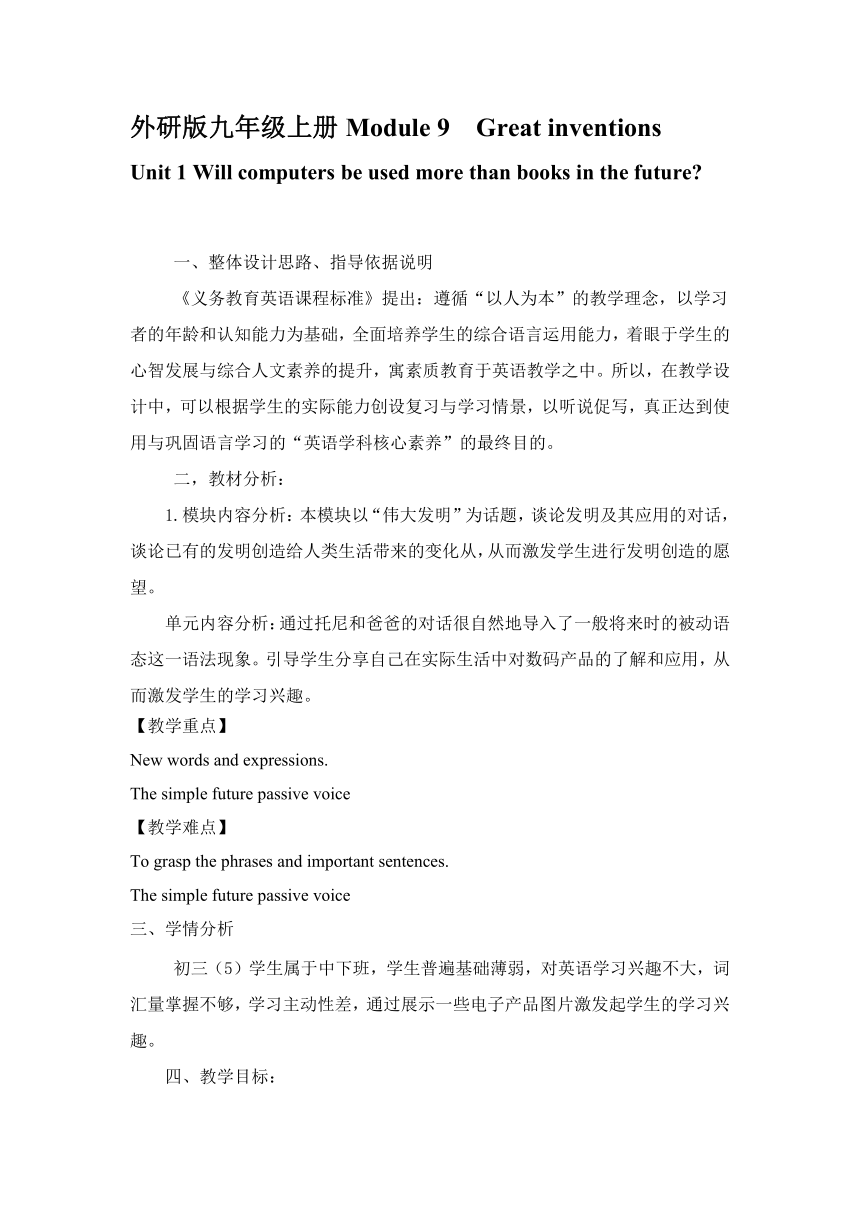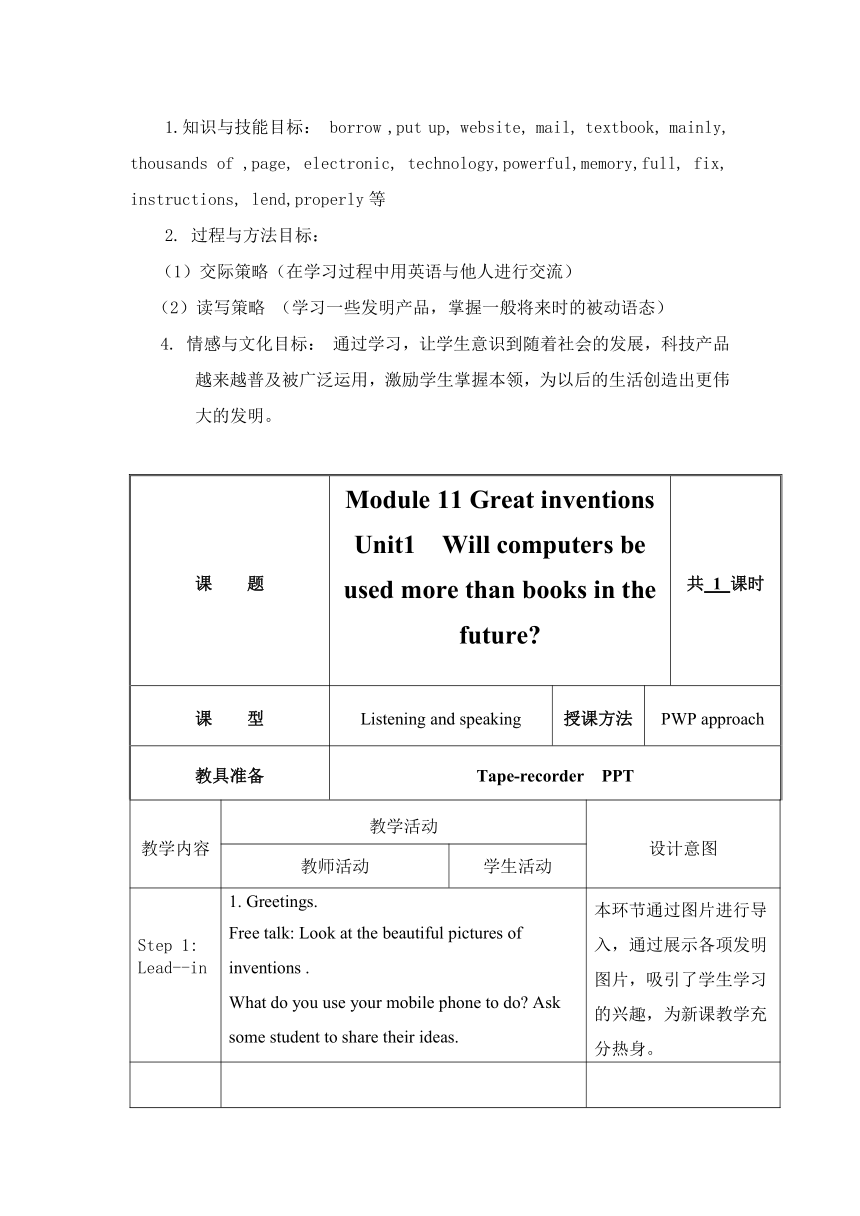Module 9 Unit 1 Will computers be used more than books in the future 教学设计
文档属性
| 名称 | Module 9 Unit 1 Will computers be used more than books in the future 教学设计 |  | |
| 格式 | doc | ||
| 文件大小 | 20.6KB | ||
| 资源类型 | 教案 | ||
| 版本资源 | 外研版 | ||
| 科目 | 英语 | ||
| 更新时间 | 2021-08-26 17:15:18 | ||
图片预览


文档简介
外研版九年级上册Module
9
Great
inventions
Unit
1
Will
computers
be
used
more
than
books
in
the
future?
一、整体设计思路、指导依据说明
《义务教育英语课程标准》提出:遵循“以人为本”的教学理念,以学习者的年龄和认知能力为基础,全面培养学生的综合语言运用能力,着眼于学生的心智发展与综合人文素养的提升,寓素质教育于英语教学之中。所以,在教学设计中,可以根据学生的实际能力创设复习与学习情景,以听说促写,真正达到使用与巩固语言学习的“英语学科核心素养”的最终目的。
二,教材分析:
1.模块内容分析:本模块以“伟大发明”为话题,谈论发明及其应用的对话,谈论已有的发明创造给人类生活带来的变化从,从而激发学生进行发明创造的愿望。
单元内容分析:通过托尼和爸爸的对话很自然地导入了一般将来时的被动语态这一语法现象。引导学生分享自己在实际生活中对数码产品的了解和应用,从而激发学生的学习兴趣。
【教学重点】
New
words
and
expressions.
The
simple
future
passive
voice
【教学难点】
To
grasp
the
phrases
and
important
sentences.
The
simple
future
passive
voice
三、学情分析
初三(5)学生属于中下班,学生普遍基础薄弱,对英语学习兴趣不大,词汇量掌握不够,学习主动性差,通过展示一些电子产品图片激发起学生的学习兴趣。
四、教学目标:
1.知识与技能目标:
borrow
,put
up,
website,
mail,
textbook,
mainly,
thousands
of
,page,
electronic,
technology,powerful,memory,full,
fix,
instructions,
lend,properly等
2.
过程与方法目标:
(1)交际策略(在学习过程中用英语与他人进行交流)
(2)读写策略
(学习一些发明产品,掌握一般将来时的被动语态)
4.
情感与文化目标:
通过学习,让学生意识到随着社会的发展,科技产品越来越普及被广泛运用,激励学生掌握本领,为以后的生活创造出更伟大的发明。
课
题
Module
11
Great
inventions
Unit1
Will
computers
be
used
more
than
books
in
the
future?
共
1
课时
课
型
Listening
and
speaking
授课方法
PWP
approach
教具准备
Tape-recorder
PPT
教学内容
教学活动
设计意图
教师活动
学生活动
Step
1:
Lead--in
1.
Greetings.
Free
talk:
Look
at
the
beautiful
pictures
of
inventions
.
What
do
you
use
your
mobile
phone
to
do?
Ask
some
student
to
share
their
ideas.
本环节通过图片进行导入,通过展示各项发明图片,吸引了学生学习的兴趣,为新课教学充分热身。
Step
2:
Learn
new
words
Step
3
Work
in
pairs
1.Show
the
pictures
of
the
new
words
to
the
students.2.
Ask
the
students
to
read
the
new
words
after
the
teacher
twice.
3.Check
some
students
.Master
the
new
words
of
this
Unit.
Look
at
the
pictures
and
answer
the
questions:
How
have
these
inventions
changed
people’s
life?
Which
one
do
you
think
is
the
most
important?
What
other
important
inventions
can
you
think
of?
通过图片的单词学习,让学生掌握这节课的新单词,为课文的学习扫除障碍。
课前讨论几个有关发明的问题,为新课热身。
Step
4:
Learn
Part
3
1.
Listen
and
answer:
Let
the
students
listen
to
the
tape
twice
and
answer
the
question:1.What
will
Tony
do
when
he
visit
to
the
museum?
2.Who
gave
the
camera
to
Tony
’s
dad?
2.Listen
and
read:
Have
the
students
listen
and
read
the
dialogue
by
themselves.
And
read
the
summary
of
the
conversation.
Underline
the
wrong
information
and
correct
it.
Tony
wants
to
borrow
his
father’s
camera
and
take
some
photos
of
the
school
dance
and
the
basketball
match.
The
photos
will
be
shown
in
the
school
magazine.
Tony
’s
dad
lends
the
camera.
He
promises
Tony
to
look
after
it.
3.Read
(1)Ask
students
to
read
the
dialogue
after
the
teacher.
(2)Read
the
dialogue
again
and
try
to
find
out
some
important
language
points
by
themselves
then
help
them
solve
the
difficult
points
if
necessary.
And
line
out
the
key
sentences
with
The
simple
passive
voice.
4.
Act
out
the
dialogue.
5.Check
three
pairs
of
students
本环节通过听、读以及分组角色扮演,了解课文内容,了解对话详情,掌握简单的短语,并画出含有一般将来时的被动语态的句子,掌握一般将来时的被动语态的用法,学会用一些重点短语造句子。
Step
5:
Learn
Part
4
1.Find
the
sentences
in
the
conversation
which
mean.
2.Check
the
answers
together.
通过完成习题,再一次复习课文。
Step
6
Learn
Part
5
Answer
the
questions.
Finish
Part
5.
学生通过讨论回答问题进行内化巩固。
Step
7
Summary
1.Get
the
students
sum
up
the
language
points.
T:
What
have
we
learned
today?
Ss:……
2.Let
the
students
choose
the
best
team
in
this
lesson.
总结所学内容,加深学生印象。
Homework:1.Finish
all
the
exercise
of
Unit1.
2.read
the
passage
three
times,
memorize
the
new
words.
板书设计:
Module9
Great
inventions
Unit1
Will
computers
be
used
more
than
books
in
the
future?
They
will
be
put
up
on
the
school
website.
Will
computers
be
used
more
than
books
in
the
future?
The
memory
card
may
be
full.
教学反思:
1.初三5班同学普遍基础差,学生不爱开口读书,单词和课文方面的带读还远远不够,对学习英语学习兴趣的培养还有待提高。2.学生对于一般将来时的被动语态掌握得不够扎实,还需多通过练习巩固这一语法点。
9
Great
inventions
Unit
1
Will
computers
be
used
more
than
books
in
the
future?
一、整体设计思路、指导依据说明
《义务教育英语课程标准》提出:遵循“以人为本”的教学理念,以学习者的年龄和认知能力为基础,全面培养学生的综合语言运用能力,着眼于学生的心智发展与综合人文素养的提升,寓素质教育于英语教学之中。所以,在教学设计中,可以根据学生的实际能力创设复习与学习情景,以听说促写,真正达到使用与巩固语言学习的“英语学科核心素养”的最终目的。
二,教材分析:
1.模块内容分析:本模块以“伟大发明”为话题,谈论发明及其应用的对话,谈论已有的发明创造给人类生活带来的变化从,从而激发学生进行发明创造的愿望。
单元内容分析:通过托尼和爸爸的对话很自然地导入了一般将来时的被动语态这一语法现象。引导学生分享自己在实际生活中对数码产品的了解和应用,从而激发学生的学习兴趣。
【教学重点】
New
words
and
expressions.
The
simple
future
passive
voice
【教学难点】
To
grasp
the
phrases
and
important
sentences.
The
simple
future
passive
voice
三、学情分析
初三(5)学生属于中下班,学生普遍基础薄弱,对英语学习兴趣不大,词汇量掌握不够,学习主动性差,通过展示一些电子产品图片激发起学生的学习兴趣。
四、教学目标:
1.知识与技能目标:
borrow
,put
up,
website,
mail,
textbook,
mainly,
thousands
of
,page,
electronic,
technology,powerful,memory,full,
fix,
instructions,
lend,properly等
2.
过程与方法目标:
(1)交际策略(在学习过程中用英语与他人进行交流)
(2)读写策略
(学习一些发明产品,掌握一般将来时的被动语态)
4.
情感与文化目标:
通过学习,让学生意识到随着社会的发展,科技产品越来越普及被广泛运用,激励学生掌握本领,为以后的生活创造出更伟大的发明。
课
题
Module
11
Great
inventions
Unit1
Will
computers
be
used
more
than
books
in
the
future?
共
1
课时
课
型
Listening
and
speaking
授课方法
PWP
approach
教具准备
Tape-recorder
PPT
教学内容
教学活动
设计意图
教师活动
学生活动
Step
1:
Lead--in
1.
Greetings.
Free
talk:
Look
at
the
beautiful
pictures
of
inventions
.
What
do
you
use
your
mobile
phone
to
do?
Ask
some
student
to
share
their
ideas.
本环节通过图片进行导入,通过展示各项发明图片,吸引了学生学习的兴趣,为新课教学充分热身。
Step
2:
Learn
new
words
Step
3
Work
in
pairs
1.Show
the
pictures
of
the
new
words
to
the
students.2.
Ask
the
students
to
read
the
new
words
after
the
teacher
twice.
3.Check
some
students
.Master
the
new
words
of
this
Unit.
Look
at
the
pictures
and
answer
the
questions:
How
have
these
inventions
changed
people’s
life?
Which
one
do
you
think
is
the
most
important?
What
other
important
inventions
can
you
think
of?
通过图片的单词学习,让学生掌握这节课的新单词,为课文的学习扫除障碍。
课前讨论几个有关发明的问题,为新课热身。
Step
4:
Learn
Part
3
1.
Listen
and
answer:
Let
the
students
listen
to
the
tape
twice
and
answer
the
question:1.What
will
Tony
do
when
he
visit
to
the
museum?
2.Who
gave
the
camera
to
Tony
’s
dad?
2.Listen
and
read:
Have
the
students
listen
and
read
the
dialogue
by
themselves.
And
read
the
summary
of
the
conversation.
Underline
the
wrong
information
and
correct
it.
Tony
wants
to
borrow
his
father’s
camera
and
take
some
photos
of
the
school
dance
and
the
basketball
match.
The
photos
will
be
shown
in
the
school
magazine.
Tony
’s
dad
lends
the
camera.
He
promises
Tony
to
look
after
it.
3.Read
(1)Ask
students
to
read
the
dialogue
after
the
teacher.
(2)Read
the
dialogue
again
and
try
to
find
out
some
important
language
points
by
themselves
then
help
them
solve
the
difficult
points
if
necessary.
And
line
out
the
key
sentences
with
The
simple
passive
voice.
4.
Act
out
the
dialogue.
5.Check
three
pairs
of
students
本环节通过听、读以及分组角色扮演,了解课文内容,了解对话详情,掌握简单的短语,并画出含有一般将来时的被动语态的句子,掌握一般将来时的被动语态的用法,学会用一些重点短语造句子。
Step
5:
Learn
Part
4
1.Find
the
sentences
in
the
conversation
which
mean.
2.Check
the
answers
together.
通过完成习题,再一次复习课文。
Step
6
Learn
Part
5
Answer
the
questions.
Finish
Part
5.
学生通过讨论回答问题进行内化巩固。
Step
7
Summary
1.Get
the
students
sum
up
the
language
points.
T:
What
have
we
learned
today?
Ss:……
2.Let
the
students
choose
the
best
team
in
this
lesson.
总结所学内容,加深学生印象。
Homework:1.Finish
all
the
exercise
of
Unit1.
2.read
the
passage
three
times,
memorize
the
new
words.
板书设计:
Module9
Great
inventions
Unit1
Will
computers
be
used
more
than
books
in
the
future?
They
will
be
put
up
on
the
school
website.
Will
computers
be
used
more
than
books
in
the
future?
The
memory
card
may
be
full.
教学反思:
1.初三5班同学普遍基础差,学生不爱开口读书,单词和课文方面的带读还远远不够,对学习英语学习兴趣的培养还有待提高。2.学生对于一般将来时的被动语态掌握得不够扎实,还需多通过练习巩固这一语法点。
同课章节目录
- Module 1 Wonders of the world
- Unit 1 It's more than 2,000 years old.
- Unit 2 The Grand Canyon was not just big.
- Unit 3 Language in use
- Module 2 Public holidays
- Unit 1 My family always go somewhere interesting a
- Unit 2 We have celebrated the festival since the f
- Unit 3 Language in use
- Module 3 Heroes
- Unit 1 She trained hard,so she became a great play
- Unit 2There were few doctors, so he had to work ve
- Unit 3 Language in use
- Module 4 Home alone
- Unit 1 I can look after myself, although it won’t
- Unit 2 I became so bored with their orders that I
- Unit 3 Language in use
- Module 5 Museums
- Unit 1 Don't cross that rope!
- Unit 2 If you ever go to London, make sure you vis
- Unit 3 Language in use
- Module 6 Problems
- Unit 1 If I start after dinner, I'll finish it be
- Unit 2 If you tell him the truth now, you will sho
- Unit 3 Language in use
- Revision Module A
- Module 7 Great books
- Unit 1 We're still influenced by Confucius's idea
- Unit 2 It is still read and loved.
- Unit 3 Language in use
- Module 8 Sports life
- Unit 1 Daming wasn't chosen for the team last time
- Unit 2 He was invited to competitions around the w
- Unit 3 Language in use
- Module 9 Great inventions
- Unit 1 Will computers be used more than books in t
- Unit 2 Will books be replaced by the Internet?
- Unit 3 Language in use
- Module 10 Australia
- Unit 1 I have some photos that I took in Australia
- Unit 2 The game that they like most is Australian
- Unit 3 Language in use
- Module 11 Photos
- Unit 1 He's the boy who won the photo competition
- Unit 2 The photo which we liked best was taken by
- Unit 3 Language in use
- Module 12 Save our world
- Unit 1 If everyone starts to do something, the wor
- Unit 2 Repeat these three words daily: reduce, reu
- Unit 3 Language in use
- Revision Module B
